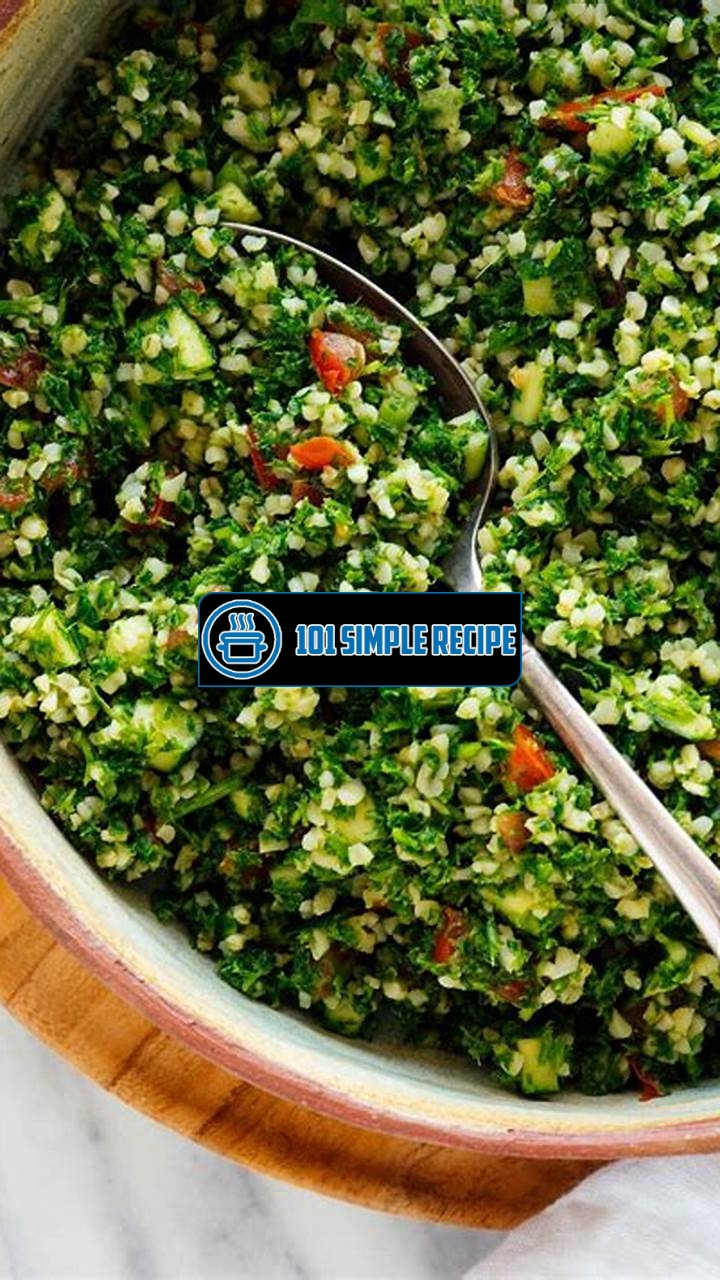Looking for the perfect dish to cool you down during the sweltering summer heat? Look no further! The Best Tabbouleh Recipe for Refreshing Summer Meals is here to save the (taste) day. ️ This traditional Middle Eastern salad is an absolute delight, bursting with flavors and textures that will leave your taste buds wanting more. Whether you’re hosting a backyard barbecue or simply craving a light and refreshing meal, this tabbouleh recipe is a must-try. So grab your ingredients and get ready to embark on a culinary journey that will transport you to sun-soaked Mediterranean shores.

What is Tabouleh?
Tabouleh is a traditional Middle Eastern salad that originated in the Levant region. This refreshing dish is known for its vibrant flavors and nutritious ingredients. It is typically served as a side dish or as part of a mezze spread.
The History of Tabouleh
The history of tabouleh dates back centuries and it is believed to have originated in the mountains of Lebanon and Syria. This refreshing salad was traditionally made using ingredients that were readily available in the region, such as bulgur wheat, parsley, mint, tomatoes, onions, lemon juice, and olive oil.
Over the years, tabouleh has gained popularity not only in the Middle East but also worldwide. Its fresh and healthy ingredients have made it a favorite among health-conscious individuals and those who appreciate traditional Middle Eastern cuisine.
The Key Ingredients of Tabouleh
The key ingredients of tabouleh include:
- Bulgur Wheat: This is the base ingredient in tabouleh and gives it a satisfying and chewy texture. Bulgur wheat is high in fiber and rich in minerals and B vitamins.
- Parsley: Fresh parsley is a crucial component of tabouleh and adds a vibrant flavor and color to the dish. It is a nutritional powerhouse, packed with vitamins A, C, and K.
- Mint: The addition of fresh mint leaves provides a refreshing and cooling element to the salad. Mint is also known for its digestive benefits and adds a delightful aroma to tabouleh.
- Tomatoes: Ripe, juicy tomatoes are essential for adding a burst of sweetness and acidity to balance the flavors in tabouleh. They are a great source of lycopene, an antioxidant that has numerous health benefits.
- Onions: Finely chopped onions lend a mild sharpness and crunch to the salad. They are rich in antioxidants and have antibacterial properties.
- Lemon Juice: Freshly squeezed lemon juice is used to dress the tabouleh, adding a tangy and citrusy element. Lemons are a great source of vitamin C and have detoxifying properties.
- Olive Oil: High-quality extra virgin olive oil is drizzled over the tabouleh to enhance the flavors and provide a smooth and velvety mouthfeel. Olive oil is rich in heart-healthy monounsaturated fats and antioxidants.
The Health Benefits of Tabouleh
Tabouleh is not only a delicious and refreshing salad, but it also offers several health benefits. Some of these benefits include:
- Rich in Nutrients: Tabouleh is packed with essential vitamins, minerals, and antioxidants, thanks to its key ingredients like parsley, mint, tomatoes, and lemon juice.
- High in Fiber: The bulgur wheat in tabouleh provides a good amount of dietary fiber, promoting regular digestion and preventing constipation.
- Aids in Weight Loss: Tabouleh is low in calories and fat, making it an excellent choice for those trying to lose weight or maintain a healthy weight.
- Heart-Healthy: Olive oil, a key ingredient in tabouleh, is known for its heart-protective properties. It helps reduce inflammation and lowers the risk of heart disease.
- Refreshing and Hydrating: Tabouleh is a hydrating dish as it contains ingredients like cucumbers and tomatoes, which have high water content.
Overall, tabouleh is a versatile and nutritious salad that can be enjoyed on its own or as a side dish. Its combination of flavors and health benefits make it a beloved dish across the globe.
If you’re looking for more delicious recipes, check out our White Castle recipe. It’s a classic favorite that’s easy to make at home.
Choosing the Right Bulgur
When it comes to making the best tabbouleh, choosing the right bulgur is essential. Bulgur, a key ingredient in Middle Eastern cuisine, adds a hearty and nutty flavor to the dish. There are different types of bulgur available in the market, each with its own unique characteristics. By understanding the different types and selecting the best variety, you can elevate your tabbouleh to a whole new level.
Understanding Bulgur: A Staple in Middle Eastern Cuisine
Bulgur is a staple ingredient in Middle Eastern cuisine, particularly in dishes like tabbouleh. It is made from cracked whole wheat berries that are partially cooked and then dried. This process gives bulgur its distinctive chewy texture and nutty flavor. It is often used as a base for salads, pilafs, and stuffing, thanks to its versatility.
Embrace the nuttiness: Bulgur’s nutty flavor adds depth to your tabbouleh, making it a satisfying and delicious dish.
Different Grades of Bulgur and Their Uses
There are different grades of bulgur available, ranging from fine to coarse. Each grade has a different texture and cooking time, which affects the overall consistency of your tabbouleh.
1. Fine Bulgur: This grade is the smallest and quickest-cooking type of bulgur. It has a soft and delicate texture, making it ideal for quick tabbouleh recipes or as a filler in burgers and meatballs.
2. Medium Bulgur: Medium bulgur is the most commonly used grade in tabbouleh recipes. It has a medium grain size and retains some chewiness even after cooking. This grade strikes a perfect balance between texture and cooking time, making it suitable for various dishes.
3. Coarse Bulgur: Coarse bulgur has the largest grain size among the different grades. It takes longer to cook and has a firmer texture. It works well in heartier tabbouleh recipes or as a base for stuffing vegetables.
Find your perfect match: Choosing the right grade of bulgur can make a significant difference in the texture and overall experience of your tabbouleh. Consider the recipe and your personal preference when selecting the grade.
Tips for Buying and Storing Bulgur
When buying bulgur, it’s essential to choose a high-quality product. Here are some tips to help you make the best purchase:
Tip: Look for bulgur that has a consistent texture and is free from impurities. It should have a pleasant aroma and not show any signs of rancidity.
Once you have bought your bulgur, proper storage is key to maintain its freshness and flavor:
- Store in an airtight container: Transfer the bulgur into an airtight container to protect it from moisture and pests.
- Keep in a cool, dry place: Store the container in a cool and dry pantry or cupboard. Avoid exposing it to direct sunlight or high temperatures.
- Check for any signs of spoilage: Before using bulgur, check for any signs of spoilage such as mold or an off odor. Discard it if it doesn’t seem fresh.
️ Keep it fresh: Proper storage ensures that your bulgur stays fresh and retains its quality for a longer period, giving you delicious tabbouleh every time.
In conclusion, choosing the right bulgur is crucial for creating the best tabbouleh. Understanding the different types of bulgur and their uses can help you make an informed decision. Whether you prefer a fine, medium, or coarse grade, each variety brings its unique texture and flavor to the dish. Remember to buy high-quality bulgur and store it properly to enjoy the freshness and goodness it adds to your tabbouleh.
Looking for a refreshing drink to serve at your next party? Try our punch bowl recipe. It’s a crowd-pleaser that’s easy to make and full of flavor.
Preparing the Veggies
When it comes to making the best tabbouleh, proper vegetable preparation is key. The flavors and textures of the vegetables you choose can greatly impact the overall taste of your dish. In this section, we will explore the techniques for prepping the vegetables that go into your tabouleh, ensuring that each ingredient is perfectly prepared to contribute to the refreshing flavors of summer.
Dealing with Parsley: The Star Ingredient
In any tabbouleh recipe, parsley takes center stage as the star ingredient. It adds a fresh and vibrant taste that perfectly complements the other flavors in the dish. To prepare parsley for your tabouleh, start by washing it thoroughly under cold water. Then, remove the leaves from the stems, ensuring that only the tender leaves are included. You can finely chop the leaves using a sharp knife or, for a more efficient method, use a food processor to achieve a finely minced consistency.
✨Pro Tip: In Lebanese cuisine, flat-leaf parsley is the preferred variety for tabbouleh. Its mild and slightly peppery flavor elevates the overall taste of the dish.✨
Choosing and Preparing the Perfect Tomatoes
Tomatoes play a crucial role in providing juiciness and acidity to balance the other ingredients in tabouleh. To choose the best tomatoes, opt for ripe ones that have a rich red color and are firm to the touch. Avoid tomatoes that are overly soft or have blemishes. After selecting the perfect tomatoes, wash them and remove the core. Chop the tomatoes into small, bite-sized pieces, removing the seeds and excess juice, as these can make the tabouleh watery.
Fun Fact: The use of vine-ripened tomatoes enhances the flavor profile of your tabbouleh, making it even more irresistible.
Handling Onions: Enhancing Flavor without Overpowering
Onions add a distinct flavor to tabbouleh but can easily overpower the other ingredients if not handled correctly. To balance the taste, it’s important to choose the right type of onion. Red onions are generally preferred for tabouleh due to their milder flavor compared to white or yellow onions.
Before adding onions to your tabbouleh, it’s advisable to soak them in cold water for about 10 minutes. This helps remove some of the pungency while still maintaining their crunchiness. After soaking, finely chop the onions and incorporate them into the tabouleh mixture.
Expert Tip: If you prefer a more subtle onion flavor, you can also use green onions (scallions) or shallots as alternatives. Their delicate taste adds a mild onion essence to the dish.
By following these techniques for preparing the veggies in your tabbouleh, you can ensure that each ingredient contributes harmoniously to the refreshing flavors of summer. From the vibrant parsley to the perfectly ripe tomatoes and the well-handled onions, your tabbouleh will be bursting with fresh and delicious flavors, making it the perfect accompaniment to any summer meal. Enjoy!
For those looking to eat healthier, our weight loss recipe is a great option. It’s packed with nutritious ingredients and is perfect for anyone on a weight loss journey.
Adding Flavor with Herbs and Spices
When it comes to creating the best tabbouleh recipe, one of the key factors is the use of aromatic herbs and spices. These ingredients are what elevate the flavors and make this dish truly delicious. So let’s dive into the world of herbs and spices that take your tabbouleh to the next level.
The Role of Mint in Traditional Tabouleh
Mint is an essential herb in traditional tabbouleh and plays a crucial role in enhancing its flavor profile. The fresh and vibrant taste of mint adds a refreshing element to the dish. It complements the other ingredients perfectly and adds a coolness that balances the flavors.
Fun fact: Mint is widely celebrated for its digestive properties and is known to aid in soothing stomach discomfort.
Exploring Other Herbs to Elevate the Flavor
While mint takes center stage in traditional tabbouleh, there are other herbs that you can explore to further elevate the flavor of this delightful dish.
Parsley, with its slightly peppery and earthy taste, adds depth to the tabbouleh. It also brings a vibrant green color to the mix, making it visually appealing. Another herb worth considering is cilantro, known for its unique citrus-like flavor that adds a zesty kick to the dish.
Hot tip: Experiment with different herb combinations to find the flavor profile that suits your taste buds best.
Understanding the Spice Blend: Allspice and Cayenne
In addition to herbs, spices also play a crucial role in creating the best tabbouleh recipe. Allspice and cayenne are two spices that bring a delightful warmth to the dish.
Allspice, with its combination of flavors resembling cloves, cinnamon, and nutmeg, adds a complex and aromatic touch. It enhances the overall taste of the tabbouleh, making it more robust.
Cayenne, on the other hand, offers a fiery kick to the dish. It adds a hint of spice that beautifully contrasts with the freshness of the herbs. However, it’s important to use cayenne sparingly to avoid overpowering the other flavors.
Remember to taste as you go and adjust the spice blend according to your preference.
By exploring different herbs and spices, you can create a tabbouleh recipe that is bursting with flavor. Whether you stick to the traditional mint or venture into new herb and spice combinations, the key is to experiment and have fun with this refreshing summer dish. So go ahead, gather your herbs and spices, and get ready to enjoy the best tabbouleh recipe that will leave your taste buds craving for more.
Dressing Your Tabouleh
When it comes to creating a delectable and well-balanced dressing for your tabouleh, there are a few key components that you should keep in mind. Mastering the art of dressing your tabouleh will take your dish to a whole new level of flavor and depth. In this section, we will explore the essential elements that will make your tabouleh truly shine.
Using Olive Oil: The Holy Grail of Tabouleh Dressings
No tabouleh dressing is complete without the heavenly addition of olive oil. This liquid gold not only adds a rich and smooth texture to your dish, but it also brings a unique fruity and slightly peppery flavor that perfectly complements the other ingredients. When choosing olive oil for your dressing, opt for extra virgin olive oil for the best quality and taste.
Pro Tip: Use cold-pressed olive oil for a more intense and authentic flavor profile in your tabouleh dressing.
Lemon Juice: The Key to Brightness and Freshness
Lemon juice plays a vital role in tabouleh dressing by providing a burst of brightness and freshness to the dish. The acidity of the lemon juice helps to balance out the flavors and enhances the overall taste of the tabouleh. Squeeze fresh lemons to extract their zesty juice, ensuring a tangy and vibrant dressing that will elevate your tabouleh to new heights.
Pro Tip: For an extra zing, zest some lemon peel into your dressing to add a fragrant citrus note.
Complementing Flavors: Garlic, Salt, and Pepper
To take your tabouleh dressing to the next level, it’s essential to include complementary flavors such as garlic, salt, and pepper. These trio of ingredients add depth and complexity to the dressing, enhancing the overall taste experience. Minced garlic adds a pungent kick, while salt and pepper bring balance and enhance the other flavors in the dish.
️ Pro Tip: For a twist of spiciness, consider adding a pinch of red pepper flakes to your dressing for an extra layer of flavor.
By mastering the art of dressing your tabouleh, you can create a truly exceptional and refreshing dish that is perfect for summer meals or any time of the year. The combination of olive oil, lemon juice, garlic, salt, and pepper will tantalize your taste buds and leave you craving more. So go ahead, experiment with different proportions and flavors, and create your own signature tabouleh dressing that will delight your palate.
Thank you for reading our article on the best tabbouleh recipe. We hope you found it informative and inspiring for your culinary adventures. The refreshing flavors and vibrant colors of this dish make it a perfect addition to any meal or gathering. Whether you’re a seasoned chef or just starting out in the kitchen, this tabbouleh recipe is sure to impress. So bookmark this page, and visit us again for more delicious recipes and cooking tips. Happy cooking!
Frequently Asked Questions
Here are some common questions about tabbouleh:
| No. | Questions | Answers |
|---|---|---|
| 1 | Is tabbouleh a healthy dish? | Yes, tabbouleh is a healthy dish. It is packed with fresh ingredients like parsley, tomatoes, cucumbers, and bulgur, which provide a good amount of vitamins, minerals, and fiber. It is also low in calories and fat, making it a nutritious choice for any meal. |
| 2 | Can I substitute quinoa for bulgur in tabbouleh? | Yes, you can substitute quinoa for bulgur in tabbouleh. Quinoa is a gluten-free grain that cooks quickly and has a similar texture to bulgur. It is a great option if you are avoiding gluten or looking for a different flavor profile. |
| 3 | How long does tabbouleh last in the fridge? | Tabbouleh will typically last for 2-3 days in the refrigerator when stored in an airtight container. However, the parsley may wilt slightly over time, so we recommend enjoying it within the first day or two for the best taste and texture. |
| 4 | Can I add other vegetables to tabbouleh? | Absolutely! Tabbouleh is a versatile dish that lends itself well to customization. You can add other vegetables like bell peppers, radishes, or even grilled zucchini to enhance the flavors and textures. Get creative and make it your own! |
| 5 | What can I serve with tabbouleh? | Tabbouleh pairs well with a variety of dishes. It is commonly served as a side dish with grilled meats, chicken, or fish. It can also be enjoyed as a topping for falafel sandwiches or as a filling for pita bread. The possibilities are endless! |
| 6 | Is tabbouleh suitable for vegans? | Yes, tabbouleh is a vegan-friendly dish. It does not contain any animal products and is made primarily from plant-based ingredients. It is a great option for vegans or those looking to incorporate more plant-based meals into their diet. |
Closing Thoughts
Thank you once again for joining us on this culinary journey. We hope this tabbouleh recipe has inspired you to explore the world of Middle Eastern cuisine and try new flavors in your kitchen. Remember, cooking is all about experimentation and creativity, so feel free to make this recipe your own by adding your favorite ingredients or adjusting the flavors to suit your taste buds. Don’t hesitate to visit our website again for more delicious recipes, tips, and tricks. Until then, happy cooking and bon appétit!
Jump to Recipe
Best Tabbouleh Recipe

Discover the best tabbouleh recipe that is packed with fresh flavors and vibrant colors. This Middle Eastern dish is a perfect addition to any meal or gathering.
- 2 cups finely chopped parsley
- ½ cup finely chopped mint leaves
- 2 cups diced tomatoes
- 1 cup diced cucumbers
- ½ cup bulgur
- ¼ cup lemon juice
- ¼ cup olive oil
- Salt and pepper to taste
- In a large bowl, combine the chopped parsley, mint leaves, tomatoes, and cucumbers.
- Add the bulgur, lemon juice, and olive oil to the bowl.
- Season with salt and pepper, and toss everything together until well mixed.
- Cover the bowl and refrigerate for at least 1 hour to allow the flavors to meld.
- Give the tabbouleh a final toss before serving. Enjoy!






